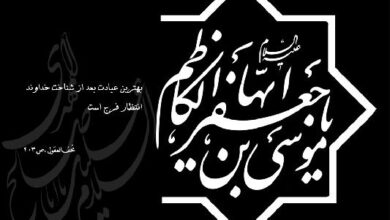Imam Jaffer (as) Is The 6th Holy Imam

Name: Jaffer (AS) is the 6th Holy Imam
Title: As-Sadiq, Sadiq-e-Aal-e-Mohammad(AS)
Agnomen: Abu-Abdullah
Father: Imam Mohammad Baqir (AS), the fifth Holy Imam
Mother: Umm-e-Farwa(AS)
Birth: 17 Rabi al-Awwal 83 AH (702 AD) in Madina.
Birth of Imam Jaffer Sadiq (as)
He was born in Medina in the year 83 A.H. and died at the age of 65 in Rajab in the year 148 A.H. He was buried with his father, grandfather, and (great-great) uncle in the al-Baqi graveyard. Umm Farwa, the daughter of al-Qasim b. Muhammad b. Abi Bakr, was his mother. His role as Imam ran for 34 years. His father, Imam Mohammad Baqir (AS), made it clear that he was in charge of the Imamate and gave him a clear name for it (nass jali).
Knowledge of Imam Jaffer Sadiq (as)
Imam Jaffer Sadiq (AS) stood out among them because of his great achievement (fadl). Both the non-Shia (al-amma) and the Shi’a (al-khassa) thought he was the most famous, the highest in rank, and the most famous of them all. People who travelled took with them sacred knowledge from him and told others about it. This spread his fame across the land. Scholars have not passed on as much information about any other member of the House (ahl al-bayt) as they have about him.
Traditions from Imam Jaffer Sadiq (as)
No one else met as many people who reported traditions as he did, and those people didn’t pass on traditions as much as they passed on traditions from Abu Abd Allah Imam Jaffer Sadiq (AS). The experts on traditions (ashab al-hadith) have put together a list of the names of the four thousand men who told stories about him and were reliable even though they had different views and beliefs. The clear proof of his Imamate was so strong that it broke people’s hearts and shut up an opponent who tried to discredit it with questions.
Political Condition during Imam Jaffer’s Period
During the time of Imam Jaffer Sadiq (as), the Umayyad Empire fell and the ‘Abbasid rule took over. This was the most revolutionary and exciting time in Islamic history. Internal fights and political changes were leading to quick changes in the government. So, the Holy Imam Jaffer Sadiq (as) saw many kings rule, from ‘Abdu ‘l-Malik to Marwan al-Himar, the leader of the Umayyads.
He lived on until the time of Abu ‘l-‘Abbas as-Saffah and al-Mansur, who were both ‘Abbasid rulers. Because of the power struggle between the Umayyads and the ‘Abbasids, Imam Jaffer Sadiq (as) was left alone to do His religious tasks and continue His goals to spread Islam and the teachings of the Holy Prophet (pbuh) without being bothered. In the last days of Umayyad rule, their empire was teetering and on the edge of falling apart, and the Islamic State was in a very chaotic and demoralized state.
The ‘Abbasids took advantage of this chance and, taking advantage of the political uncertainty, took on the name “Avengers of Banu Hashim.” They claimed to have been on the side of getting even with the Umayyads for killing the innocent Imam Hussain (as). People who lived under the rule of the Umayyads were sick of their cruelty and privately wished that the Holy Prophet’s children would take over.
They knew that if the leadership went to the Ahle-Bayt, who were the rightful heirs, Islam’s reputation would rise and the Prophet’s message would be spread more honestly. But a small group of ‘Abbasids quietly spent their lives trying to take power from the Umayyads under the guise that they would give it to the Banu Hashim if they were successful. In fact, they were making plans to help themselves. So, the ordinary people were tricked into backing them, and when the ‘Abbasids took power from the Umayyads, they turned against the Ahle-Bayt.
Imam Jaffer Sadiq (as) and His religious services
During the time when Imam Jaffer Sadiq (as) was in charge, He had more chances and a better environment to spread Islamic ideas. This happened because of revolts in Islamic Lands, especially the revolt of the Muswaddah to overthrow the Umayyad empire, and the terrible wars that led to the Umayyads’ downfall and extinction. Shi’ite teachings had more chances to spread because the fifth Imam had done a good job of spreading the true teachings of Islam and the studies of the Household of the Prophet during his twenty years as Imam.
Pupils of Imam Jaffer Sadiq (as)
Imam Jaffer Sadiq (as) used the event to spread knowledge about religion until the end of his rule, which was around the same time as the end of the Umayyad and start of the Abbasid caliphates. Imam Jaffer Sadiq (as) taught many thinkers, like Zorarah, Muhammad ibn Muslim, Mu’min Taq, Hisham ibn Hakam, Aban ibn Taghlib, Hisham ibn Salim, Hurayz, Hisham Kalbi Nassabah, and Jabir ibn Hayyan, the magician, in different fields of intellectual and transmitted sciences. Even important Sunni thinkers like Sufyan Thawri, Abu Hanifah, the founder of the Hanafi school of law, Qadhi Sukuni, Qadhi Abu’l-Bakhtari, and others had the honour of being his students.
Imam Jaffer Sadiq (as) taught Ahadees to 4 thousand masters
People say that four thousand masters of hadees and other fields learned from Imam Jaffer Sadiq (as) classes and lessons. There are more stories from the fifth and sixth Imams that have been kept alive than from the Prophet and the other ten Imams put together.
There are too many stories about him that are similar to the ones we’ve told about signs and revealing the unknown for us to tell them all.Imam Jaffer Sadiq (as) used to say, “We know what will happen (ghabir), what has happened (mazbur), what is written on hearts (nakt fi al-qulub), and what is heard (naqr fi al-asma). We have the red case (jafr), the white case, the scroll of Fatima (s.a.), and the paper al-jami’a, which has everything the people need.”
He was asked to explain these words, and Imam Jaffer Sadiq (as) said, “Ghabir is knowledge of what will be; mazbur is knowledge of what was; what is written in the hearts (nakt fi al-qulub) is inspiration; and what is tapped into the ears (naqr fi al-asma) are the words of angels; we hear their words but do not see their shapes. The red case (jafr) is a container that holds the Apostle of God’s weapons. May God bless him and his family.
It won’t leave us until the member of the House who is meant to get up (qa’im) gets up. The Torah of Moses, the Gospels of Jesus, the Psalms of David, and the (other) Books of God are kept in the white case (jafr). Peace be on her, Fatima’s paper has the names of all the kings and every event that will happen until the (last) hour. The al-jami’a is a 70-yard-long paper that the Apostle of God, may God bless him and his family, spoke and Ali b. Abi Talib, peace be on him, wrote down in his own handwriting.
By God, it has everything people will ever need until the end of time, right down to blood-wit for wounds and whether a full or half beating is due.
Imam Jaffer Sadiq (as), peace be on him, used to say, “My traditions are my father’s traditions; my father’s traditions are my grandfather’s traditions; my grandfather’s traditions are the traditions of Ali b. Abi Talib, the Commander of the faithful; the traditions of Ali the Commander of the faithful are the traditions of the Apostle of God, may God bless him and his family; and the traditions of the Apostle of God, may God bless him and his family, are the word of God, the Mighty and High.”
Martyrdom of Imam Jaffer Sadiq (as)
At the end of Imam Jaffer’s life, the Abbasid caliph Mansur put a lot of restrictions on the Imam. Mansur also tortured and killed so many Shi’ite descendants of the Holy Prophet (pbuh) that his actions were even worse than those of the Umayyads, who were known for being cruel and careless. On his orders, they were caught in groups. Some were put in deep, dark prisons and abused until they died. Others were beheaded, buried alive, or put at the base of or between building walls, and walls were built over them.
The Umayyad ruler, whose name was Hisham, had arrested Imam Jaffer Sadiq (as) and brought to Damascus. Later, the Abbasid governor Saffah kidnapped the Imam Jaffer Sadiq (as) and brought Him to Iraq. Finally, Mansur had him caught again and taken to Samarrah, where the Imam Jaffer Sadiq(as) was kept under watch. Mansur was rude and mean to the Imam jaffer Sadiq (as), and he thought about killing Imam several times. In the end, Imam Jaffer Sadiq(as) was allowed to go back to Medina, where He stayed hidden for the rest of his life until Mansur poisoned Him and killed Him.
When Mansur heard that Imam Jaffer Sadiq (as) had been killed , he wrote to the governor of Medina and told him to go to the Imam’s house under the guise of sending his respects to the family, ask for the Imam’s will, and read it. Whoever the Imam Jaffer Sadiq (as) picked as His replacement and heir should be killed on the spot.
Mansur’s goal was, of course, to end the whole question of the imamate and Shi’ite hopes. When the governor of Medina was told to read the Imam’s last will and testament, he saw that the Imam(AS) had chosen four people instead of just one to carry out his wishes: the caliph, the governor of Medina, the Imam’s older son ‘Abdullah Aftah, and his younger son Imam Musa-e-Kazim(AS). In this way, Mansur’s plan didn’t work.




